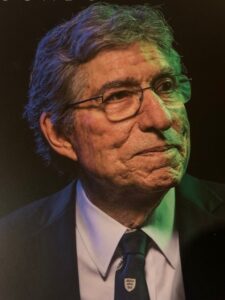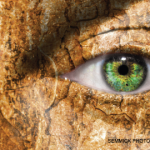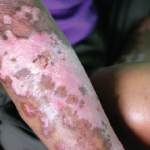 Rheumatologists who are outstanding researchers, educators and/or clinicians, who provide consistently exceptional care to patients, who have achieved a level of distinction in the field and who serve as role models for colleagues and trainees are highlighted in this recurring series.
Rheumatologists who are outstanding researchers, educators and/or clinicians, who provide consistently exceptional care to patients, who have achieved a level of distinction in the field and who serve as role models for colleagues and trainees are highlighted in this recurring series.
Fred Wigley, MD, MACR, is the Martha McCrory Professor of Medicine at the Johns Hopkins University School of Medicine, Baltimore. In 1990, Dr. Wigley established the Johns Hopkins Scleroderma Center to provide excellent care to patients with scleroderma, Raynaud’s phenomenon and related disorders; to perform clinical and basic science research; and to provide educational opportunities. His primary research interest is in scleroderma, Raynaud’s phenomenon and related disorders. He has published more than 180 peer-reviewed manuscripts. He has served as co-editor of Arthritis & Rheumatology, and he has co-edited the books Scleroderma: From Pathogenesis to Comprehensive Management and Raynaud’s Phenomenon: A Guide to Pathogenesis and Treatment. In 2009, Dr. Wigley received the ACR Distinguished Clinician Scholar Award and, in 2011, he was named an ACR Master.
TR: In your opinion, what makes an expert clinician?
Dr. Wigley: When I first started my rheumatology career, I would accept any request. In this phase of my career, I focus on scleroderma, a chronic disease that can shorten one’s life, cause terrible disability and alter the body’s appearance.
I like to start the patient encounter without any preceding information that may influence my judgment. I usually start the visit with some non-medical conversation to relax the visit. The evaluation of the patient starts as soon as the face-to-face encounter begins, and I use my senses to characterize the patient: sick or not sick, nervous or calm, sad or happy, etc. I open the interview with an open question and then listen.
I then try to refine the facts by getting all the fine details of the patient’s symptoms. It is then important to me to review every system not already mentioned to unearth symptoms or signs that need attention or that interact with the principal concern. I then review records and previous medical facts to set the scene for the examination.
I ask the patient to undress and get into a gown to do an exam focused on the main issue, but allowing me to carefully look for the unexpected.

Dr. Wigley
The final phase of the encounter is communication and making sure the patient understands the plan and intervention. I use pen and paper or printed pictures to illustrate my thoughts. This approach is used for new and return patients so each encounter is fresh.
It is most important to finish an encounter with the question, “How are you handling things?” It takes time to openly discuss the emotional impact of the illness, but it is most important. It is common to discover distress that is not mentioned. These days, I see the eyes begin to tear behind the COVID face masks.
The patient-doctor relationship is unique, based on trust and a special type of loving friendship. All my clinical activity is held together by a passion for my work, a clear understanding of my limitations, a willingness to seek help from my colleagues, a desire to understand the biology behind the clinical events and a constant attempt to do whatever is needed to comfort and improve my patient’s quality of life. I still have a view that what I decided today may not be ideal and refreshing my view of the problem and my treatment should be reviewed at each encounter.
I am pretty sure that listening and being available to provide comfort to my patients are very powerful medications.
TR: Who were some of your clinician role models and what qualities did you admire in these individuals?
Dr. Wigley: When I was in high school, my family physician was Dr. Louis Michaelos, a tall, handsome, Greek man with thick, dark eyebrows and a gentle manner who looked like the doctor I hoped to become. Later, while in medical school, I spent a month-long rotation working in his office and began to learn some of the skills I use today. He would always start the encounter by taking the vital signs himself, telling me, “It is most important to gently touch your patient so you connect.” He was aware of his limitations as a primary care physician and made referrals so the patient got the expert help that they needed.
In medical school, I worked with Robert Waldman, MD, who was an immunologist and did his clinical training at Johns Hopkins. He helped me appreciate the importance of understanding basic biology and applying it to the care of patients; he also launched my clinical research career.
During my training at Johns Hopkins there were many who influenced me, including my colleague Ernest Arnett, MD. There were many talented members of the faculty, including Philip Tumulty, MD; Victor McKusick, MD; and C. Lockard Conley, MD. Dr. Conley was an incredibly gifted scientist and clinician who discovered the lupus anticoagulant.
During my fellowship, Mary Betty Stevens, MD, was brilliant and nurtured my career.
During my faculty years, the major (among many) mentors have been my colleague in pulmonary medicine, Robert Wise, MD, and my first postdoctoral fellow, Antony Rosen, MBChB, MS, who is a superb leader and basic scientist and a world-class clinician.
TR: What habits can a fellow in training or junior rheumatologist incorporate into daily practice to build their skills as a clinician?
Dr. Wigley: Today, the physician is burdened not only with making sure the quality of information is good, but also with entering volumes of data into the computer. This is occurring with increasing demands for care and stress to act quickly. The time we spend with direct patient care is shrinking as we are consumed by data collection and documentation. The time with our eyes on the computer far outweighs the time we have for the patient. While there is incredible potential for integrating comprehensive, paperless information and data collected into our patient care, the technology is moving faster than the research to provide evidence that it makes a difference.
We need to recognize that escaping old ideas and methods is very hard to do and one should not get stuck in their internship mode. Rather, many old principles are essential to treasure:
- Allow time for your senses to be used during each encounter to characterize the patient.
- Listen carefully and focus on body language as the patient relates his or her problems.
- Guide the patient with questions to unearth symptoms and signs.
- Allow time for the patient to have an exam that is designed to address the problem and, yet, have a routine system to explore unexpected signs and clues.
- Take time to stop and think, remembering your limitations and the need to consult with others and to double check plans and interventions.
- Never accept a rumored diagnosis; convince yourself the evidence is solid (e.g., review labs, images and pathology yourself), and recognize the complex biological networks that may influence your therapy (e.g., age may influence responses).
- Make sure you ask patients how they are coping and that they understand the plan. Our goal is not only to treat the patient’s disease, but to also improve their quality of life as they experience it.
- Communicate carefully in an unrushed manner during the visit, but also provide ways for the patient to ask for help anytime.
- Finally, follow up. The answer to the problem and the response to your intervention often is revealed in the chapters that unfold before you and help tell the story and solve mysteries.
TR: What lessons have you learned from patients that have contributed to your own growth as a clinician?
Dr. Wigley: I have learned so many lessons from patients that have tuned my skills and made me a better doctor. In fact, every patient sends a message and an experience that fills my list of how to be a good doctor. Here are a couple of examples:
Once, when in medical school, we had a rotation at the Mayo Clinic in Florida where interns worked with residents to provide healthcare to a community with no local doctors. We cared for a patient with a large staphylococcal abscess. Periodically, an attending from the university would come and make rounds to teach and to actually see patients. One visit was from an infectious disease expert from Gainesville, who was a world-renowned expert on staphylococcal infections. He examined the patient’s abscess and made some recommendations. The patient looked up and said: “Am I going to see my doctor today?”
Lesson: Your relationship with the patient comforts the patient more than your credentials.
Another lesson was from a young woman with end-stage scleroderma lung disease and secondary pulmonary hypertension on high-flow oxygen. In the last days of her life, she looked up at me and said: “My lungs are no good, but I feel fine. I am happy and content with my life and family.”
Lesson: Recognize that, despite unrelenting disease, patients overcome distress for the important elements of their life. Give them that opportunity.
A third lesson was from a gentleman with rheumatoid arthritis. It was a time before biologics were available, but with injection therapy and then methotrexate, I controlled his disease. I was very pleased with his status and level of function. He came for a follow-up and gave me a self-portrait. The painting portrayed sadness and distress; he was dressed in a striped, prison-like shirt. I talked with him and realized there were deep emotional issues I had not addressed.
Lesson: I had treated the disease, but not the patient.
TR: What skills, habits, or experiences have you found most helpful in finding the right diagnosis in medical mystery cases that heretofore had been unsolved?
Dr. Wigley: The major skill is leaning on experience. Once I see something I try to learn all about it so that next time it is encountered I have expertise to apply.
I listen carefully to the patient and then clarify concerns so that all of the patient’s symptoms are clear and understood. I try to do a careful exam that I customize for the specific issue (e.g., an expanded neurological exam, if needed), but then do a pre-designed survey of all systems. I figure if you do not look, you do not see. Once, I found an asymptomatic melanoma on the sole of a foot that I would have missed if I had not removed the socks.
It is most important to witness the problem and to reproduce the symptoms during the exam if possible. I like to clean the slate and not accept a diagnosis given to the patient until I review the evidence myself.
I find it helpful to think about a cause of symptoms in categories, like pain that is inflammatory or misery that is mechanical in nature. Another method is to try to link the symptom or sign to a biological process, such as malignancy, metabolic, autoimmune, etc. I recognize that, often, a disease does not match the textbook description and that features may emerge with time. Therefore, designing a targeted work-up and then reevaluating at some set interval—or if new symptoms emerge—is key. Serial observations often solve the mystery.
Finally, I recognize my limitations and seek consultation to discuss the case in detail with expert colleagues. This guides my workup and often solves the tough cases.
TR: How do you approach the concept of uncertainty when entertaining a diagnosis for a patient?
Dr. Wigley: I learned a long time ago that what we think is the gospel today is often changed with new discoveries. We no longer bleed every patient to remove evil factors. When I was in medical school, we admitted patients with hepatitis for weeks of bed rest.
I deal with a disease—scleroderma—that in the early stages can be challenging to diagnosis.
Patients often present with nonspecific symptoms (e.g., fatigue, weight loss, joint and muscle aches) that precede the full expression of the disease. When a patient presents with some features and I cannot make a definite diagnosis, I manage the problem that I can define. For example, problematic Raynaud’s may be treated with a vasodilator alone if other clinical features of a disease process are still occult. I emphasize to the patient that the diagnosis is not as important as defining a sensible, safe management plan of an active problem and then carefully revisiting the situation.
If I sense the patient is acutely ill or a disease process is progressing, then the laboratory investigations are expanded to seek clinically occult disease. If the patient is clinically doing well on symptomatic intervention, then serial observations and appropriate new studies are carefully planned.
Chapter two of the disease story is often needed to make a diagnosis.
 Jason Liebowitz, MD, is an assistant professor of medicine in the Division of Rheumatology at Columbia University Vagelos College of Physicians and Surgeons, New York.
Jason Liebowitz, MD, is an assistant professor of medicine in the Division of Rheumatology at Columbia University Vagelos College of Physicians and Surgeons, New York.



